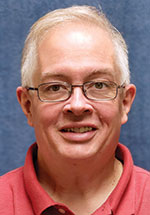Faith and Family / Sean Gallagher
Facing intimidation with an unwavering faith as our forbearers did
 A century ago, the Ku Klux Klan controlled the levers of political power in Indiana. The racist, anti-immigrant and anti-Catholic organization claimed hundreds of thousands of Hoosier members.
A century ago, the Ku Klux Klan controlled the levers of political power in Indiana. The racist, anti-immigrant and anti-Catholic organization claimed hundreds of thousands of Hoosier members.
In May 1924, it sought to flex its social muscle by staging a large rally and parade in South Bend with its large Catholic population and its famous Catholic university.
But the students of the University of Notre Dame would have none of it. About 500 of them gathered in downtown South Bend, taking the white hoods off of the Klan members, meeting others arriving in trains and buses, grabbing their regalia.
The Klan’s attempt to intimidate the Catholics of South Bend quickly failed.
A year later, the Klan organization across the state went quickly downhill after its charismatic leader,
D.C. Stephenson, was convicted of rape and murder.
My paternal grandfather, Victor Gallagher, graduated from high school in 1924. Born into a strong Catholic farming family in rural Johnson County, he wanted nothing more than to be a farmer himself. Being a student at Notre Dame was never something he aspired to.
But Grandpa had something of the fight of the Fighting Irish students who stood up to the Klan in 1924. I remember him telling me of fist fights he got into in high school with “Ku Kluxers.”
And he remained strong in his faith in the face of Klan members burning a cross in a field across the road from his family’s farm as he came of age in the early 1920s.
By the time I knew Grandpa 50 years after the height of the Klan’s power in Indiana, Hoosier Catholics had achieved great success in society. They contributed much to the common good, holding political office, leading businesses and serving in many professions.
Growing up at that time, I never knew the social pressures against Catholics in the state that Grandpa faced. But I’m glad that he shared his experiences with me, experiences that I’ve told to my five sons.
The stories about Grandpa that I tell them go far beyond fist fights, though. They include how he prayed the rosary with my dad as they worked together on their family farm and later taught me to pray it when I was a child.
How he went to confession each week simply because, in his words, “I’m a sinner.” How he anonymously helped a poor family have a good Christmas and taught my father, a child at the time, a lesson in Christian charity that stuck with him for the rest of his life.
I pray that I can live up in some small way to the example Grandpa set for me. I want to do this not only for the good of my own soul, but for my boys as well.
As good as Grandpa’s stories are that they hear with their ears, my sons will benefit more from the example of faith they see in me with their eyes.
Being strengthened in their own faith by examples from my wife Cindy, me, our parents and grandparents will be even more important for my sons as they come of age.
For while the Klan may no longer be the force it was a century ago in Indiana, social pressure against living the faith publicly is on the rise again, if in different ways than it was in 1924. Then, it was related to anti-immigrant sentiment in society. Now, it has as more to do with a wide range of the Church’s moral beliefs.
I pray that my sons and the Catholics of their generation will remain, like Grandpa, steadfast in their faith in the storms to come. †
 A century ago, the Ku Klux Klan controlled the levers of political power in Indiana. The racist, anti-immigrant and anti-Catholic organization claimed hundreds of thousands of Hoosier members.
A century ago, the Ku Klux Klan controlled the levers of political power in Indiana. The racist, anti-immigrant and anti-Catholic organization claimed hundreds of thousands of Hoosier members.